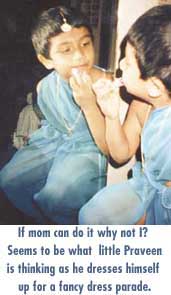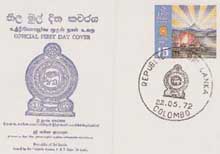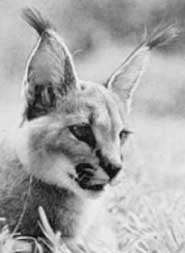 |
 17th May 1998 |
Front Page| |
|||

|
|||||
My best friendSarika - ever smiling, lovable, pleasing, helpful with lots of child like graces - she is my favourite friend. I have many friends and among them Sarika is my best friend. She is very popular in my class. All the students in my class like her. She is eleven years old and her birthday is on September 5. She lives in Hendala. She is short, fair and thin. She has got beautiful short black hair. She comes from a middle class family. Her father is working at Bank of Ceylon and her mother is a teacher. She has two sisters and a brother. She is the youngest in her family. Her hobbies are reading books and watching TV. Her favourite TV programmes are cartoons and her favourite cricketer is Rahul Dravid. Sarika is very fond of toys. She has many toys and she has her own toy cupboard. She likes to eat chocolates and loves to drink milk. Her favourite colour is orange, because she is in Scott House in school. She has a parrot, two dogs and one rabbit. She loves them very much. She is the best example for a friend. A friend in need is a friend indeed. M. Shereen 10, Nimala Mariya Mawatha, Hendala, Wattala.
My selfMy name is Sanjeewa Sanath. I am twelve years old. I was born in 1986. My native place is Galle but now I live at the Barahasooriya children's home in Hikkaduwa. I have many brothers with me at the home. I love them a lot. Our home is beautiful and clean. I like to play cricket and my anbition is to be a Policeman. Sanjeewa Sanath Year 7
The Birth of a RepublicMay 22 is a significant day in the history of Sri Lanka. It was on May 22, 1972 that the Republic of Sri Lanka was inaugurated. Prior to that, Sri Lanka (then known as Ceylon) was an Independent Dominion within the Commonwealth of Nations acknowledging the Queen of England as its sovereign. At the appointed hour of 12.43 p.m. on May 22, 1979 the President of
the Constituent Assembly, Stanley Tillekeratne (who was also the Speaker
of the House of Representatives) signed and certified the Constitution.
Mrs. Sirimavo R.D. Bandaranaike took her oaths as the first Prime Minister
of the A 15 cent stamp depicting the rays of the rising sun behind Sri Pada with a lotus in full bloom in the foreground was issued to mark the occasion. The stamp designed by L.D.P. Jayawardena was in yellow, blue, magenta and black. For the first time the word 'Sri Lanka' Replaced ' Ceylon' on the stamp. (Earlier ' Sri Lanka' appeared in Sinhala on our stamps ). ' Janarajaya', the Sinhala term for 'Republic' appeared on the stamp along with the Tamil equivalent. The insignia used on the stamp was not the one adopted for the Republic. Possibly it had not been finalised at the time the stamps were printed. The correct insignia appeared in the official First Day Cover issued by the Philatelic Bureau. The symbols used in the insignia were the Punkalasa (filled vessel), the heraldic lion within the Palapeti Vataya (lotus petal border), the Dhammachakra (Wheel of the Doctrine), the Sun and the Moon, and the Ear of Corn. These signified Prosperity, Discipline, Righteousness, Eternity and Self-sufficiency respectively. Let us briefly look at how the new constitution was adopted. Following the victory of the United Front (Sri Lanka Freedom Party, Lanka Sama Samaja Party & Communist Party) at the 1970 General Election, Prime Minister Sirimavo Bandaraniake convened a meeting of all Members of the House of Representatives at the Navarangahala on July 19, 1970. At this meeting it was decided that the members would constitute themselves into a Constituent Assembly for the purpose of adopting a new constitution declaring Sri Lanka to be a Free, Sovereign and Independent Republic, pledged to realize the objectives of a Socialist Democracy including the fundamental rights and freedoms of all citizens. In furtherance of this resolution, the Constituent Assembly adopted a set of Basic resolutions, which formed the guidelines on which the legal text was to be drafted. The principal features of the Constitution, which was adopted on May 22,1972 were a Supreme Legislature, a Cabinet system of government and an independent Judiciary. Fundamental rights and freedoms were guaranteed and a Constitutional Court was to decide whether prospective legislation conflicted with the provisions of the Constitution. This Constitution was in force until the promulgation of the Constitution of the Democratic Socialist Republic of Sri Lanka on September 7, 1978.
SensesThe senses of animals have evolved to suit the way they live. Sometimes an animal's life-style makes one sense particularly important, and this may be developed at the expense of the others. Sight Sight is one of the most important senses that animals have. There are
many kinds of eyes, ranging Simple eyes are only able to detect changes in how much light there is, while more complex eyes can see images clearly in three dimensions, and often in colour. Sight helps an animal to find its food or to see if it is being hunted. The eye of a vertebrate is a very complex structure. There is a transparent "window" at the front called the cornea. Light passes through this to the lens, where the amount allowed into the eye is controlled by the coloured part called the iris. The lens focuses the light on to the light-sensitive cells at the back of the eye, which are called the retina. Hearing For most animals, the sense of hearing is just as important as sight. It helps them know not only that something may be approaching, but also how quickly, and even its probable size. Ears The sense organ used for hearing is the ear. These are two flaps of skin on the outside of the head. Most animals have two ears, one on each side of the head. This helps to locate the direction the| sound is coming from. The flaps channel sounds, as vibrations in the air or water, into the ear, where they hit the ear drum. Behind the ear drum is the middle ear cavity, where the vibrations are sent through a series of little bones to the inner ear. From the membrane of the inner ear the vibrations are then sent through a spiral cavity called the cochlea. This is where nerve cells pass on the signals to the brain. Blind people are often more aware than sighted people of the differences in sounds. They use echoes to judge their distance from objects. Touch, taste and smell Nearly all animals are sensitive to being touched. More primitive creatures like the amoeba respond to touch by simply moving away. More advanced animals can interpret the feeling and alter their behaviour accordingly. The senses of taste and smell are very closely related. The range of tastes that can be judged by the taste buds on the tongue is very limited, but the sense of smell adds to it. Smell helps animals recognize their territories and members of their own social group. |
|||||
 |
Return to Mirror Magazine Contents
|
||||
 |
Please send your comments and suggestions on this web site to |
||||

 Republic
of Sri Lanka. Governor -General, William Gopallawa was sworn in as the
President of the Republic.
Republic
of Sri Lanka. Governor -General, William Gopallawa was sworn in as the
President of the Republic. from
the simple light-sensitive cells of some invertebrates to the more complex
and highly specialized eyes of the vertebrates.
from
the simple light-sensitive cells of some invertebrates to the more complex
and highly specialized eyes of the vertebrates.